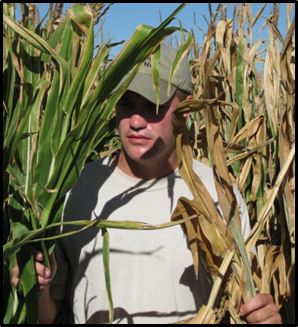Drought Tolerance
Late-Season drought tolerance in maize and sorghum
 The ability of a plant to postpone senescence under late-season drought is commonly defined as 'stay-green'. Stay-green is correlated with enhanced crop productivity, grain quality, and lodging resistance in many crops. Retention of green leaf tissue is known as visual stay-green, whereas functional stay-green is defined by maintenance of photosynthetically active tissue. The goal of our research is to characterize the expression and genetic architecture of stay-green in maize and sorghum. This knowledge will be applied to improving drought tolerance of these and other crops through marker-assisted selection and potentially transgenic approaches.
The ability of a plant to postpone senescence under late-season drought is commonly defined as 'stay-green'. Stay-green is correlated with enhanced crop productivity, grain quality, and lodging resistance in many crops. Retention of green leaf tissue is known as visual stay-green, whereas functional stay-green is defined by maintenance of photosynthetically active tissue. The goal of our research is to characterize the expression and genetic architecture of stay-green in maize and sorghum. This knowledge will be applied to improving drought tolerance of these and other crops through marker-assisted selection and potentially transgenic approaches.
Maize exhibits substantial genetic variation for stay-green. Joint linkage mapping has been used to identify multiple QTL for stay-green across several linkage groups with sources of stay-green alleles coming from diverse genetic backgrounds. Comparisons between maize and sorghum for map positions of stay-green QTL indicate that two of the major loci occur in syntenous regions. Identification and integration of stay-green genes into commercial programs provides the opportunity to sustainably enhance the productivity of maize and sorghum in drought environments.
